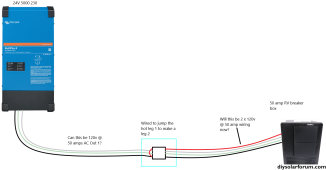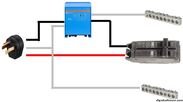You're proposing powering your RV in the same manner as when you plug into 30A power with a 30 to 50A adapter. L1 and L2 are jumpered to L, so you have 120V to each side of the AC panel.
When powered by 120/240V split phase, the only current on the neutral will be the imbalance between the legs, e.g., 20A on L1 and 30A on L2 means you only get 10A on N. In the jumpered config, N is the return for both legs, so 20A on L1 and 30A on L3 would be 50A on the N.
Unless you're hooked to shore power. The Quattro has a 100A transfer switch, so it will be happy to provide 100A pass through, AND it will also happily provide ANOTHER 42A with power assist. That's a potential of 142A.
Assuming any source you plug into is limited to 50A, you'll be limited to 50A... plus... the 42A of power assist, so 92A.
You could very easily overload your wiring while on shore power. Your first clue will be the smell of burning insulation.
Disagree with this as an absolute. My single 5kVA Quattro can power both A/C pretty easily. I've run both for several hours in upper 90°s. That's a total of about 3000W continuous.
I should clarify, I don’t mean it as an absolute, I’m just talking from experience in a large, ultra well equipped RV, and I suppose with the X factor of a wife.
Ours had dual 15k btu air conditioners, full size residential fridge, four TV’s, an electric fireplace we never used, big microwave etc.
We would often see draw reaching 3,800w from the two AC units, especially as the temps would rise. This didn’t leave much headroom for anything else. You get the wrong timing of the fridge kicking on, or the wife throwing something in the microwave and boom, you’re in overload.
This was most annoying when away from the RV, dogs inside, AC blaring and coming back to it in overload for some reason. I do however take responsibility for it being set up in split phase rather than parallel, which would have been a much more effective setup allowing the two inverters to share the load rather than splitting the panel.
I think if I were to do a large RV again I’d go with a Victron 10k, or run the numbers and see if one of the smaller 8k/12k Sol-Arks would end up being cheaper. The Victron stuff is rock solid, just ends up expensive when you get it all pieced together.
Lots of options out there, many of which are great. Heck, aside from high idle draw I’d think an older MPP LV6548 would be an excellent fit.
OP, if you’re willing to go without a warranty, and can accept the idle draw, this is a CRAZY good deal for your setup. Could grab two and be well ahead price wise. Just a thought:






